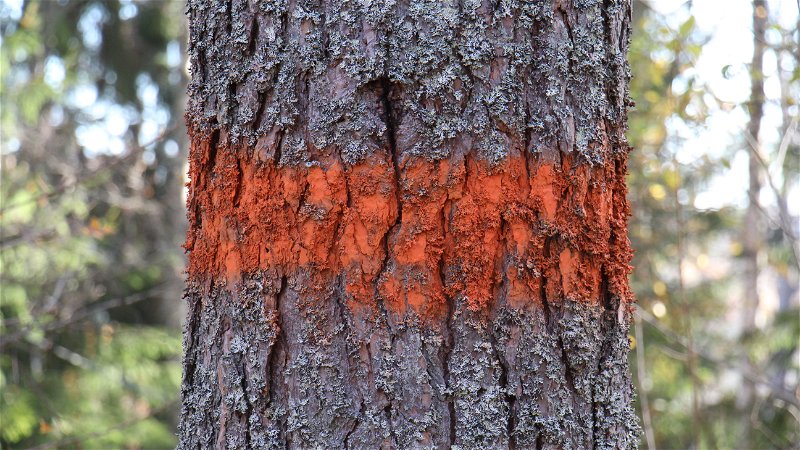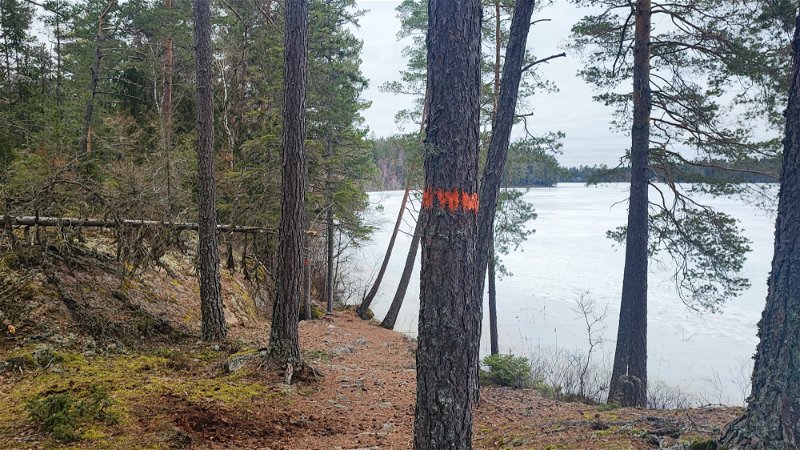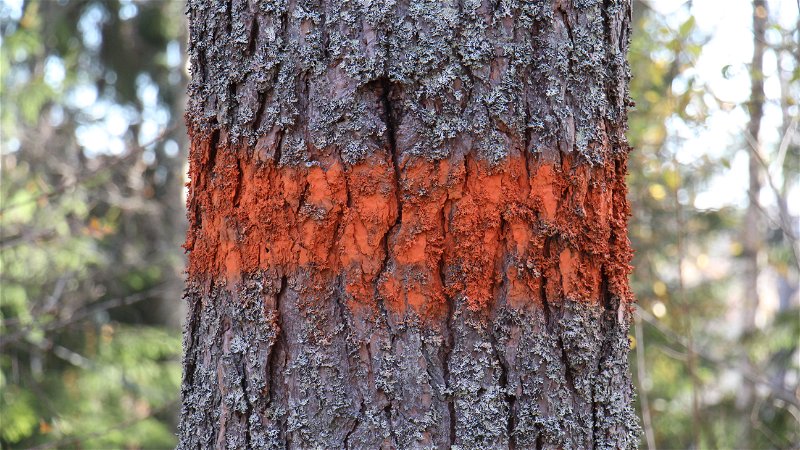Stage no. 8 is easy, except when you pass Stingsberget. Almost the entire route is on forest trails, but towards the end you come out on a forest road and then the country road that goes up through Ramnäs. There is also a short road walk when you pass Surahammar.
Like stage 7, this stage starts at Långsjön. After following the edge of the lake for 1.5 km, the path splits. Stage 7 turns right towards Toftsjön while stage 8 goes left towards Surahammar. From here you walk through mostly quite dense forest with large elements of wetlands. After about 5 km you pass the outskirts of Surahammar. Make a detour through the community down to the old mill area with Strömsholm's canal, the mill museum, and the motorcycle museum Gyllene Hjulet where you can see a copy of Sweden's first car manufactured in Surahammar.
The walk continues past the Surahammar golf course. Now follows 1.5 kilometers where sparse pine forest with elements of rocky outcrops stand around you. The stretch is nice and easy to walk. Soon you will arrive at Stingsmossen and Rövallsmossen nature reserve. Here Bruksleden passes in the western corner of the reserve and from the trail you only see glimpses of Stingsmossen on the right.
After a few more kilometers, it starts to slope up towards Stingsberget and the easy terrain is replaced by a slightly more demanding one. From the top of Stingsberget, which is about 25 m above the surroundings and 109 m above sea level, you get a magnificent view of the Kolbäcksån valley up towards Ramnäs. Take a break up here and enjoy the beautiful view. Stingsberget is usually used as an open-air church.
The pine forest continues on the other side of the mountain. You arrive at a crossroads where the stage merges with stage 7 again. The last bit to Ramnäs you first go on a small forest road that starts out at road 66. On the way into the center you pass Ramnäs church, built before 1450. The church has a beautiful tower with an onion dome. Outside Ramnäs, just south of road 66, is Gniens nature reserve, which is one of Västmanland's most species-rich bird habitats.
RESTING PLACES
There is a shelter where the stage starts at Långsjön. The shelter has a nice location with lake views and can accommodate 6-8 people. Around it there are several nice tent sites.
At the top of Stingsberget there are benches where it is nice to take a break and admire the view.
SURAHAMMAR
The mill town of Surahammar is located at the intersection of Mälardalen and Bergslagen. The name Sura comes from the old name for a lake or watercourse. The Kolbäcksån river flows through the community and there was already a hammer here by the river in the 16th century. In 1637, a new hammer was built by Axel Oxenstjärna on the site where the mill is today. In 1866, Surahammar's mill began manufacturing railroad wheels. Over time, the railroad wheel has become the mill's most famous product and production is still going on today. At the Mill Museum you can follow the manufacturing process from pig iron to finished wheels. The Mill Museum is housed in a workshop from 1840. A large number of tools have been preserved here, and the hammers and ovens are still where they were when the mill was in operation.
Another thing that has made Surahammar famous is that it was here that Sweden's first car with an internal combustion engine was developed. It was designed in 1897 by engineer Gustav Eriksson on behalf of Peter Petersson, then manager of the mill. You can see a replica of the first car at the Gyllene hjulet motorcycle museum. Here you can also see one of the first mass-produced cars, a Vabis from 1903. The motorcycle museum is the largest of its kind in Sweden. Here you can follow the development of two-wheelers and see around 130 motorcycles.
Stenhuset is Surahammar's oldest residential building in stone. It was built for six blacksmith families in 1847 and each apartment consisted of a large kitchen and a smaller chamber. The house was inhabited until 1962 and one of the apartments is preserved and furnished as a residence in 1900. At Stenhuset there is a coffee shop and a shop selling arts and crafts. Here you will also find Surahammar's tourist office.
Surahammar's mill area is part of the Ekomuseum Bergslagen.
RÖVALLSMOSSEN AND STINGSMOSSEN NATURE RESERVE
This species-rich nature reserve is dominated by the two large bog areas Rövallsmossen and Stingsmossen. They are two well-formed bogs separated by a ridge of solid ground called the island. The reserve also includes surrounding forest areas. The bogs are home to many northern plant species, such as sedge, white sedge and dwarf birch. Out on the bogs, heather, crowberry, cloudberry and tufa grow.
The bird life is rich and if you are lucky you may be joined on your walk by cranes, golden plovers, curlews, greenlegs and shrikes. There may also be black grouse.
The aim of the reserve is to preserve the mire areas and the adjacent woodland with its flora and fauna. The wetlands and parts of the woodlands will be allowed to develop freely without human interference.
Rövallsmossen was leased by the armed forces during the Second World War for use as a target shooting range. Traces of that time remain in the form of a number of concrete lumps out on the bog.
Remember that special regulations apply within the nature reserve (see the county administrative board's website for information).
GNIENS NATURE RESERVE
Gnien, just south of Ramnäs, is considered to be one of the county's finest bird lakes. The reserve covers the lake, which is an extension of the Kolbäcksån river, as well as the surrounding shore meadows and various types of natural forest environments around it. The aim of the reserve is to protect the valuable waterside meadows and create a good environment for the wetland-dependent birds that live here.
The salt meadows are kept open by grazing cattle. Every year the meadows are flooded, which benefits bird life in spring and autumn when many species rest in the area. Whooper swans, ducks, oystercatchers, teals and greenlegs can be found here. Many species worthy of protection nest in the area, such as shoveler, corncrake, curlew and black tern. Birds of prey such as osprey, buzzard and lark falcon are also common.
In the eastern part of the reserve there is a birdwatching tower, which you can reach via a boarded path from a parking lot by road 252.
Remember that special regulations apply within the reserve (see the county administrative board's website for information). In order not to disturb the bird life, it is forbidden to enter the beach meadows and the water area between March 15 and May 15.
RAMNÄS
Ramnäs, like most of the other towns along the Bruksleden trail, has a centuries-old history of use. In 1590, Ramnäs' first bar iron hammer was built by Gustav Vasa's widow, Katarina Stenbock, on the rushing Kolbäcksån river. It was named Kungshammaren. Several hammers were built in the 17th century.
Taking a tour through Ramnäs' historic mill environment, which today is largely a museum, is an exciting and interesting experience. You can, for example, get a guided tour among the machines in the world's last Lancashire forge, which was in operation from 1855 until 1964. Lancashire forging is a type of bar iron forging technology that came from England and characterized the Swedish iron industry for more than 100 years. In the mid-19th century, Ramnäs was the country's largest producer of bar iron. At this time, the company began to manufacture chains, a product that over the years has made Ramnäs widely known. The old chain forge is preserved and can be visited. It is also possible to make a study visit and see the modern production of the world's largest anchor chain.
Two beautiful mansions are located on the mill site.
Schenströmska manor was built in 1762 and is located on Strömsholm canal next to the Lancashire forge. The owners have included both knights and mountain councils. Today it is used as a conference hotel. Next to Schenströmska is Tersmedenska Manor, from 1801, which is privately owned.
Today, Ramnäs has three successful companies that carry on the mill tradition, Scana, Gunnebo and Franke Ramnäs Rostfria AB. They mainly manufacture chains for supertankers and oil platforms.
Ramnäs mill environment is part of Ekomuseum Bergslagen.
LIVING AND EATING
Go to the link to read about where you can stay and eat in Surahammar and Ramnäs. Read more '
SHOPPING FOR FOOD
Food shops are located in the center of Surahammar and Ramnäs. In Surahammar, the center is located about 2 km west of the pedestrian tunnel under road 66 that Bruksleden passes through.
OTHER
Below Schenströmska mansion is Ramnäs guest harbor. There is a service building with shower and toilet that you can use for a fee.
READ MORE
Directions
From Västerås, VL bus no 114 goes to Surahammar. You can get off the bus where Bruksleden crosses road 66 at Långsjön. From here it is less than a kilometer to the starting point of the stage, the windbreak at Långsjön. On weekends, the bus only runs two tours on Saturdays and none on Sundays.
The easiest way to get to Surahammar is by train. You take the train that runs on the line Västerås - Hallstahammar -Surahammar - Fagersta - Ludvika
You can also get to Surahammar by Brukslinjen from Kvicksund - Kolbäck or Virsbo -Ramnäs. Most services run only on weekdays.
The train between Västerås and Ludvika stops in Ramnäs.



